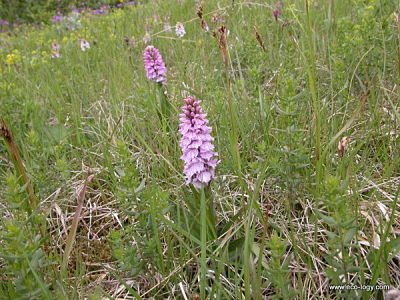Botany News
Welcome to this fifteenth edition of Botany News!
TOPICS:
1. A note from the editor
2. Plants grown in northern gardens: Strawberries
3. The hardy plants of Iceland
4. Green tabloid: Global warming
5. A special announcement to Icelandic readers
6. The flower box
Visit our website:
Eco-Logy.com
A note from the editor
Greetings and welcome back to Botany News!
Hope you enjoy this new issue. Summer has arrived, bringing sunshine and warmer weather to Iceland. Hiking on the coast, parks, gardens, and suburbs of Reykjavik, you see and smell the budding trees, green herb leaves and emerging grasses. Many garden plants are already in bloom; white and purple crocuses, bright yellow daffodils, and blue and white anemones to name a few. This issue of Botany News contains topics of interest to all botany enthusiasts. Search our site and Botany News archive for valuable articles and bookmark your favourite items for future reference. If you enjoy this ezine and the Eco-logy.com web feel free to share our articles with your friends. Check out our Botanical Tour option and plan a visit to Iceland this summer!
Plants grown in northern gardens: Strawberries
Strawberries are stoloniferous herbs, producing five-divided, usually white flowers and fleshy, red juicy fruits. Rich soils and plenty of sunlight are important for strawberries; such conditions may be found at forest edges and south-facing slopes. While the berries are delicious, strawberries are also medicinal herbs against intestinal problems.
Three species of strawberries, Wild Strawberry (Fragaria vesca), Musk Strawberry (F. moschata) and Creamy Strawberry (F. viridis), grow wild in Europe. Wild Strawberry being the most widespread and the only species of strawberries growing wild here in Iceland. Wild Strawberry is common in South and West Iceland. While vegetative growth with runners is strong, wild strawberries may produce ornamental white flowers and later tiny edible berries in sheltered sunny spots here in Iceland. Musk Strawberry (F. moschata) is a native European species and quite common in central Europe. Musk Strawberry extends its distribution to other parts of Europe including Scandinavia, Britain, and Spain. Creamy Strawberry (F. viridis) has a similar distribution, but does not grow in the wild in Britain.
The common strawberry, the Garden Strawberry (Fragaria × ananassa ) is a hybrid between two American species Beach Strawberry (Fragaria chiloensis) and Virginia Strawberry (Fragaria virginiana). The Garden Strawberry can be grown in gardens as far north as Iceland. Developing berries need to be protected from birds. For a commercial harvest Garden Strawberries are cultivated in greenhouses in some countries in Northern Europe and North America, good knowledge of the biology of Garden Strawberries and relevant horticultural techniques is needed for greenhouse cultivation of this species on large scale.
The hardy plants of Iceland
Conditions here in Iceland are often unfavourable for plant growth. In parts of the country, barrens have formed as a consequence of long-term overgrazing and destructive natural forces. The highlands of Iceland have wide-ranging black deserts. Commonly, the soil is poor containing much sand and gravel. Sands are arid and infertile with rapid loss of nutrients and water. Among the successful plants on drifting sands are the tuft-forming, coarse Lyme-grass (Leymus arenarius) and the stoloniferous Fiorin (Potentilla anserina), binding the sand with rooting nodes.
On the gravelly barrens of both highland and lowland river banks you may find the exquisite River-beauty Willow-herb (Chamerion latifolium) bearing large, pink flowers. Muddy gravels may fragment into characteristic gravel polygons as a consequence of alternating soil freezing and thawing processes. On wet gravels you may find the delicate pink-flowered Hairy Stonecrop (Sedum villosum), the sturdy Two-flowered Rush (Juncus biglumis), the drooping Spiked Wood Rush (Luzula spicata), and growing from green rosettes the Tufted Saxifrage (Saxifraga caespitosa), cushion plants such as Thrift (Armeria maritima) and the pleasant, white-flowered Alpine Mouse-ear (Cerastium alpinum).
Green tabloid: Global warming
Most of the sunlight reaching the Earth is in the spectrum of visible light. The radiation emitted from the Earth has longer wavelengths than the incoming radiation. The gas molecules of the atmosphere absorb a fraction of the long wavelength radiation from Earth. The denser the concentration of gases, the more heat is trapped near the Earth and as a consequence Earth’s surface temperature increases. Mankind is contributing to an increase of this warming or greenhouse effect of the atmosphere. The general warming of Earth’s climate systems during the last two centuries is called global warming, most of this recent warming is thought to be the result of human activity. Global warming is expected to increase in the future causing shifting ranges of plant populations with regard to latitude and altitude and population decline for species that are unable to adjust. The whole ecosystem and food webs are also under threat.
Gasses that participate in trapping the planet’s heat emission are called greenhouse gasses. The most common ones in the atmosphere are water vapour and carbon dioxide. Carbon dioxide plays a central role in the Earth’s chemical cycling and ecosystems, being a key component of both terrestrial and marine ecosystems. It enters the ecosystems through the process of photosynthesis in green organism plants, algae or photosynthetic bacteria. Other gas types that add to the greenhouse effect are to a large extent by-products of human activity, among them are methane, ozone and nitrous oxides. The effect of the different gasses depends in the amount and the type of molecule. For example, methane contributes twenty times more to the greenhouse effect than carbon dioxide. Fortunately, methane is found in a very low concentration in the atmosphere.
The climatic warming underway this century is expected to have a profound effect on the biosphere and species geographic distribution. Global warming could affect agricultural communities and wilderness areas, the hardest hit likely being fragile and sensitive vegetation such as the Arctic tundra and desert areas and their inhabitants. It is therefore important to try and reverse the effect of global climate change.
A special announcement to Icelandic readers - Tilkynning!
Sendið okkur bréf og greinar um gróður til birtingar í næsta hefti Gróðurfrétta (Botany News), þið getið líka skoðað fyrri hefti á netinu. Hægt er að hafa tengla á ykkar vefsíður á tenglasíðunni. Í fréttabréfinu má finna ýmislegt efni um villtar plöntur og nytjaplöntur. Miðlið af ykkar eigin fróðleik til annarra um efni eins og plöntur, ræktun, náttúru landsins og útivist. Sendið okkur tilkynningar og greinar um fjölbreytt efni tengt náttúruupplifun, garðyrkju og umhverfislist. Fyrir þau ykkar sem hafið áhuga á náttúrlegum jurtavörum til gjafa má skoða á sölusíðu Þundar. Te og krydd frá Þund henta vel til smágjafa, í næsta boð eða fyrir klúbbinn! Fylgist með nýjum vörum frá Þund, gerist áskrifendur að fréttabréfinu eða setjið vefinn Eco-logy.com í bókarmerki hjá ykkur. Oreganó og oolong te eru nýjar vörur frá Þund. Póstsendum te og kryddvörur innanlands.
The flower box
Plan a visit to Iceland this spring and explore the country's amazing nature, where volcanic rock formations, birch forests and green pastures each have their own distinctive flora and wildlife. Become familiar with Iceland's unique plant life through one of our Botanical Tours in Iceland. Botany News welcomes letters from people working on all aspects of botany, ecology and conservation. In particular, we welcome contributions from persons working for the environment, biodiversity and conservation around the globe. Please, feel free to send us brief articles or recommend new links to exceptional botanical and green pages to be included in the next Flower Box section. Submit your Botany News article or announcement!
----------------------------------------------------------------------------
Best wishes,
Soffia Arnthorsdottir
BOTANY NEWS is published by Thund, Reykjavik, Iceland
Contact us
May 17, 2012 -- Botany News, Issue #015



Fáðu nýjustu fréttir og tilboð frá Þund!
Get updates and special offers from Thund!











